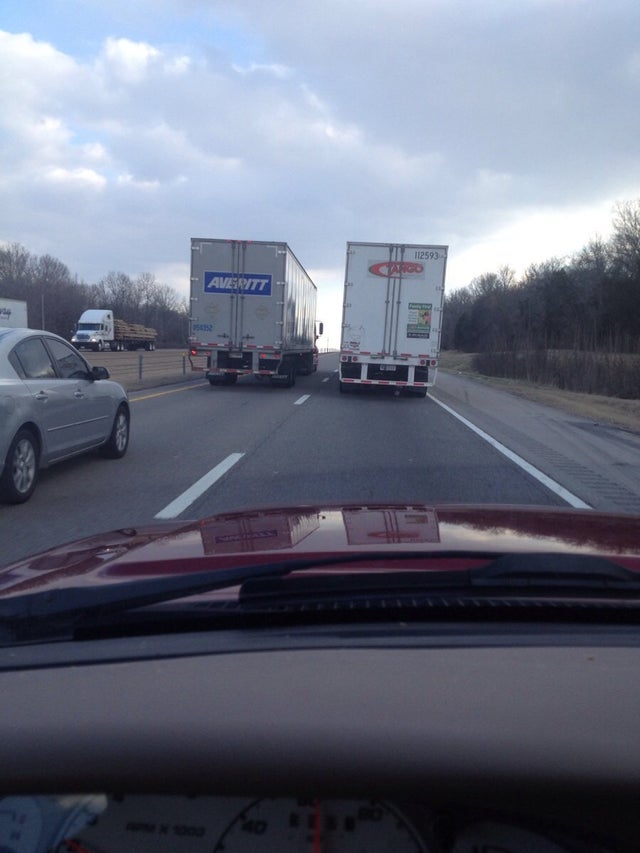Before we took to the road in August 2016, we rarely did much driving. We didn’t commute to work. If we went somewhere we flew. Our cars had very few miles on them. We were only occasional visitors to the interstate highway system, and had even less exposure to the web of two-lane highways that fill the spaces between them. I wasn’t even sure I liked driving.
But once we got on the road, we quickly understood that the highway is a complex social system. It is, of course, a system with laws, rules, and norms, but those rules and norms don’t always hold. Drivers are in their cars or trucks or big trucks, and seem to feel that the vehicle that surrounds them creates for them an anonymity in which they can hide. It’s somewhat akin to the anonymity people rely on on the internet when they engage in behavior that they would never attempt when face to face or recognizable. People behave in ways while cocooned in their cars and trucks that they never would as pedestrians exposed to others on the street.
Everyone on the highway is trying to get somewhere, and many want to get there as fast as they can. The law slowing many people down is the speed limit. But an indication of how important it is to people to get there fast is the fact that the most commonly broken laws in America are speed limit laws. As you’re reading this, there are millions of people across the country breaking speeding laws. If all the speeders were caught and fined, state revenues would rise by billions. Beyond that, we all know that speeding is dangerous, leads to accidents, and causes death — often to the speeding driver. Yet it seems to be human nature to ignore the risks and speed.
With millions of cars, pickup trucks, and motorcycles speeding to their destinations, the biggest frustration drivers face on the highway is other drivers getting in their way — driving too slowly, keeping them from passing, blocking their progress. The most annoying of these other drivers are in the fast lane where they don’t belong. They don’t seem to accept the idea that the fast lane is for fast drivers. Or maybe they do, but encased in their vehicles feel immune to the norm that obligates them to get out of the way. Something they wouldn’t do if they risked being confronted.
A surprising amount of the interstate highway system in this country is only four lanes wide — two in each direction. You find this in places you wouldn’t imagine. I-95 through South Carolina, Virginia, and elsewhere, and I-5 through long stretches of California. These are the two principal north-south highways in the United States, and they carry tens of millions of cars each year. Why are they carrying all this traffic in each direction on only two lanes? Where’s the infrastructure bill? It only takes one inconsiderate or oblivious driver in the fast lane on one of these stretches to slow everything down and create a long backup of annoyed drivers who want to go, want to speed.
The slow lane on the interstate is always full of slower drivers, RVs (particularly in the summer), cars towing something, buses, and eighteen-wheel big rigs. As long as they know to stay there, things work as the speeders speed by in the fast lane. There is the exception of drivers who want to play in the fast lane with the big kids but really can’t keep up with the true speeders and exacerbate the problem when they grow nervous and slow down before passing a big truck that’s in the slow lane. The knock-on effect of this nervous slowing creates backups and frustration. But there are worse offenders.
The list of worse offenders begins with the thoughtless who belong in the slow lane but move into the fast lane. There are drivers who think they’re driving fast but aren’t. They’ve got no business over here with the true fast drivers going through. There are drivers so nervous they can’t drive in the slow lane and feel safer in the fast lane because they can use the solid line on the left edge of the fast lane to guide them along. There is also a whole class of pickup truck drivers. Unlike the solid-line huggers, I think they know exactly what they’re doing. They drive slowly in the left lane, their window is down, they know they’re holding up traffic, they don’t care, they’re up higher and their truck is bigger than the cars they’re delaying, and they never move over even when the slow lane becomes empty. Pass them on the right you must.
The next class of offenders are drivers in RVs or cars pulling something. They try to pass something driving even slower than they are in the slow lane, end up taking too long to pass, and create a long line of cars and annoyed drivers behind them.
The biggest offenders, however, are in the biggest vehicles. Professional drivers. Truckers. As you’re coming upon them, they are a caravan of four or five trucks traveling in the slow lane. They seem from a distance to all be traveling at the same speed. Then one of them turns sharply into the fast lane to begin a long, slow process of passing the truck in front of it. The truck being passed is doing 56 miles per hour. The truck doing the passing has a maximum speed of 56.5. It’s going to take a long time for it to get around and get back in the slow lane and out of the way. Cars racing up the fast lane at 80 mph are hitting their brakes and nearly each other. Truck drivers use the enormous size of their trucks to intimidate car drivers when they need to squeeze into the fast lane. And then stay there with an impunity conferred on them by their size. In their side mirrors, the truck drivers can see the long line of unhappy car drivers now struck behind them as they ever so slowly try to overtake the truck in the slow lane. The truck in the slow lane never slows a little bit to allow the truck blocking the fast lane to get around faster. This would be an insult to that driver’s manhood. And the driver clogging the fast lane never gives up. No matter how long the line of cars behind him in the fast lane, he won’t admit defeat, slow slightly, and get back in the slow lane behind the truck he was trying to pass. Those of us in our cars just wanting to get by and resume our speeding must watch this slow motion duel between two behemoths of the highway with an impatience evolving into anger.
These truck drivers know what they’re doing. They know they’re preventing strangers in cars from getting by, from speeding to their destinations. They know it’s inconsiderate. They know it’s breaking the law in some states. But it’s giving them a sense of control more important to them than common courtesy.
The difference a third lane makes — particularly when trucks are restricted to the middle and right lanes — is enormous. Enormous enough to justify the infrastructure bill, and the widening of America’s clogged arteries — its interstate highways.


